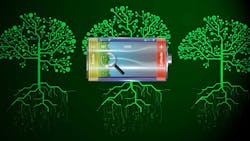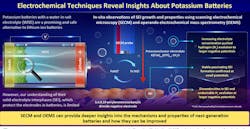Aqueous Potassium-Ion Batteries: Insights into Next-Gen Solutions
What you'll learn:
- Advantages of a potassium-ion battery.
- How does a water-in-salt electrolyte help in making a potassium-ion battery viable?
- Tokyo University of Science's advanced methodology that was used to gain more in-depth insights into this battery chemistry.
Despite disadvantages that can’t be ignored, lithium-ion batteries have become the go-to power source for a wide variety of electronic devices and vehicles over the past two decades. These shortcomings include the limited availability of lithium as well as safety and environmental concerns.
As a result, scientists are looking at alternative battery technologies. With the development of highly concentrated electrolytes, aqueous batteries are gaining momentum as a promising and safe alternative to the lithium-ion (Li-ion) battery. One aqueous battery chemistry is potassium-ion, which is much safer than Li-ion.
Moreover, potassium-ion batteries can utilize a water-in-salt electrolyte (WISE), which makes them more stable thermally and chemically. The use of a WISE that contains only a few moles of water (molarity is number of moles of solute present in one liter of solution) is believed to significantly improve the electrolyte stability window of typical aqueous electrolytes from 1.23 V up to >3 V.
One major challenge in high-voltage aqueous batteries is stabilization of the negative electrode. Stabilization requires the prevention of hydrogen evolution at the negative electrode. H2 evolution is the cathodic reaction in the electrochemical splitting of water and is one of the principal means of producing hydrogen for use as a reagent or as a fuel. Very low voltage electrodes as found in commercial and emerging batteries, e.g., alkali metals, graphite, etc., are too reactive for application in WISEs.
SEI Formation with Potassium-Ion Batteries
But while research on the topic has been relatively scarce with regard to potassium-ion batteries, scientists from Tokyo University of Science (TUS) in Japan recently published a study “In-situ Observation of Evolving H2 and Solid Electrolyte Interphase Development at Potassium Insertion Materials within Highly Concentrated Aqueous Electrolytes” in the journal Angewandte Chemie International Edition, August 18, 2023.
The researchers used advanced scanning electrochemical microscopy and mass spectrometry to gain insight into solid-electrolyte interphase (SEI) formation and its properties in WISE-based potassium-ion formulations. The SEI that forms between electrodes and the electrolyte solution helps stabilize the electrodes in Li-ion batteries by preventing electrolyte decomposition and self-discharge of the batteries.
The study was led by TUS Professor Shinichi Komaba and is co-authored by Junior Associate Professor Ryoichi Tatara, Dr. Zachary T. Gossage, and Ms. Nanako Ito, all from TUS.
SECM and OEMS Tests
The researchers observed how SEI prevents electrolyte decomposition and reacts in real-time during the operation of a potassium-ion battery. Scanning electrochemical microscopy (SECM) measurements enabled the team to gain deeper insight into the SEI that occurs within highly concentrated WISEs, a passivating (leads to a protective oxide layer) but discontinuous SEI film.
Operando mass spectrometry (OEMS, an analytical methodology wherein the spectroscopic characterization of materials undergoing reaction is coupled simultaneously with measurement of catalytic activity and selectivity) confirmed a shift in the evolution of detectable H2 from −0.9 V to <−1.4 V vs. Ag/AgCl when changing from dilute to concentrated electrolytes. However, the team noted that the observed SEI was discontinuous at the surface and H2 evolution occurred as the electrode reached more extreme potentials.
A “First” Discovered with SEI
The experiments revealed for the first time that SEI forms a passivating layer in WISE akin to that seen in Li-ion batteries, with slow apparent electron transfer rates, helping suppress hydrogen evolution. This can ensure stable performance and higher durability of potassium-ion batteries, though the team said more quantitative analysis is needed in future work. The researchers also observed that the coverage of the SEI layer was incomplete at higher operating voltages, leading to hydrogen evolution.
Taken together, the results underscore the need to explore potential avenues to enhance SEI formation in future aqueous batteries. “While our results reveal interesting details on the properties and stability of SEI found in one particular WISE, we should also focus on reinforcing the SEI network to achieve improved functionality,” said Prof. Komaba.
He added, “SEI could perhaps be improved by the development of other electrolytes that produce unique SEIs, but also through the incorporation of electrolyte additives or electrode surface pretreatment.”
This study resulted in a better understanding of electrode-electrolyte interactions in next-generation batteries. “These techniques provide a powerful means for tracking the development, coverage, ion transfer, and stability of SEI, and can easily be adapted for a variety of electrolytes and electrodes,” explained Prof. Komaba.
A More Sustainable Future?
The development of aqueous batteries such as those with potassium-ion chemistries will be instrumental for sustainable societies in the future. They could replace the expensive and hazardous Li-ion batteries currently used in electric vehicles, smart grids, renewable-energy systems, and marine applications.
By making energy storage more accessible, aqueous batteries will aid the transition toward carbon-neutral energy generation, paving the way for a greener future.

